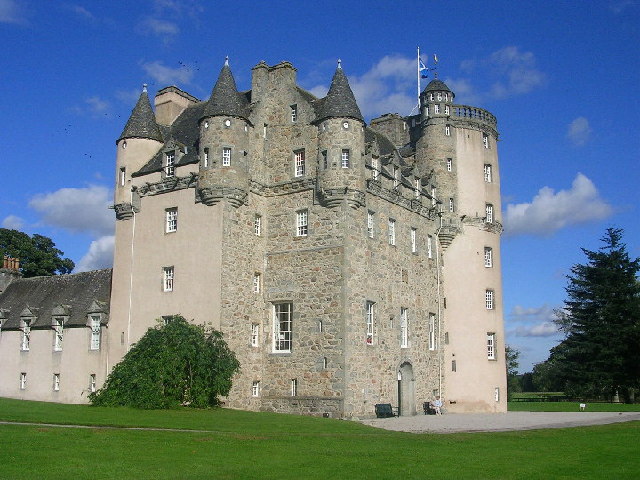Scotland is home to a host of spectacular castles. Famed for their breathtaking surroundings, they are also key to unlocking the country’s remarkable history
In a nation swirling with stories of ferocious clan rivalries and battles against the ‘auld enemy’, England, it is perhaps no surprise that Scotland is blessed with a seemingly infinite number of castles.
Over the centuries, the need for strategically important fortifi cations was replaced with the desire for grand residences that allowed the feudal lords to live in luxury. The main challenge for visitors to Scotland today is not scaling mighty ramparts, but deciding which of the country’s majestic castles to visit. Properties managed by the National Trust for Scotland (NTS), a conservation charity that has been working tirelessly to protect the country’s cultural heritage since 1931, make fascinating choices.
Kellie Castle
Casting a protective eye over the East Lothian coastline, Kellie Castle is one of the most historic castles in Scotland, with a heritage that stretches as far back as 1150. Its famous former owners include Sir Walter Oliphant (who was married to Robert the Bruce’s youngest daughter, Elizabeth) and Sir Thomas Erskine. In 1600, Erskine reputedly helped save King James I of England (VI of Scotland) from an apparent assassination attempt in a chain of events known as the Gowrie Conspiracy.
After falling on hard times, Kellie Castle was given a new lease of life by the Lorimer family who restored it between 1878 and 1970. The exquisite craftsmanship of Sir Robert Lorimer – renowned for his restoration of historic castles and grand houses – has left Kellie Castle with an important artistic legacy. Highlights include the furniture crafted by Sir Robert Lorimer and paintings by John Henry Lorimer. Kellie Castle also stakes claim to intricate plaster ceilings that are among the oldest and most ornamental in Scotland.
Hew Lorimer, one of the nation’s most famous stone sculptors and nephew to John Henry, shared his uncle’s artistic talent. The studio where he worked here is open to visitors. The NTS took over Kellie Castle in 1970 and have spent the last 40 years ensuring that the building, its interior and grounds are maintained in a way that is sensitive to its 14th-century heritage and the surrounding area.
Brodick Castle
Flanked by the majestic hulk of Goat Fell mountain on one side and the Firth of Clyde on the other, Brodick Castle, on the Isle of Arran, is another of Scotland’s most impressive stately castles. There has been a fortress on this commanding site since the late 13th century. Over the centuries, defences were put to the test as the castle was repeatedly attacked. It also garnered the attention of the Lords of the Isles in 1455 and became a battleground for warring clans – the Campbells and the MacLeans, then the Campbells and the Hamiltons – at intervals during the 16th and 17th centuries. This lasted until 1650 when Oliver Cromwell’s Roundheads took control of the castle and it was transformed into a military barracks.
Now, when wandering around the peaceful and immaculately landscaped gardens of the only island country park in Britain, it is interesting to think that this site of fierce battles has been transformed into a bucolic paradise. Dating from 1710, the Walled Garden is one of Brodick Castle’s most celebrated outdoor spaces, as is the Woodland Garden with its wonderful collection of rhododendrons.
Like the grounds, the castle is very different from the original structure, with the years of violent struggles necessitating various rebuilds. In the mid-19th century, the Hamilton family made Brodick Castle their principal residence, and a massive extension project transformed it into the Victorian mansion that visitors see today. Inside, the artefacts on display include the imposing stags heads that line the walls of the entrance hall (there are 87 of them) and an extensive silverware collection. Touring the private apartments where the Hamiltons lived until the National Trust for Scotland took over in 1958, offers an insight into the daily life of what it was like to live at Brodick Castle. Like Brodick Castle and Kellie Castle, Castle Fraser, in Aberdeenshire, also evolved to meet the demands for more spacious and luxurious residential accommodation.
Castle Fraser
The approach taken by the first laird, Thomas Fraser, who built the tower-house castle back in the mid-15th century, was very different. When Thomas Fraser first extended Castle Fraser in around 1570 he made sure that its original design wasn’t compromised and simply added two additional towers to create a classic ‘Z-plan’ tower house. This first wave of expansion was fi nally completed in 1618. Two more wings were added in the 1630s giving the castle its present-day appearance.
In the middle of the 18th century, events conspired to leave the castle empty and it was left to fall into ruin for almost 200 years. Reprieve came in the form of Clive Pearson who, having been gifted the castle by his father-in-law the First Viscount Cowdray, set about restoring Castle Fraser between 1921 and 1946. His daughter Lavina kept up his good work before giving the castle to the NTS in 1976. In addition to continuing with the repairs, the NTS were able to purchase an additional 320 acres of land (bringing the total to 346 acres) in 1993, returning the castle to its rightful position at the heart of a large country estate. Highlights of a visit to Castle Fraser today include the Great Hall, which dates back to the 1400s, the old library and the 18th-century embroideries in the Worked Room.
Designed from the outset to be a palatial family home, Crathes Castle, also in Aberdeenshire, is one of the bestpreserved castles in Scotland. Inhabited by the Burnetts of Leys for over 350 years, it has remained virtually unchanged since its completion in 1596. From its enchanting pink exterior to its ornate interior, every aspect of Crathes is enthralling. Delving into the ‘L-plan’ tower house, where the opulent living quarters are spread out over six floors, visitors are treated to vivid painted ceilings that hark back to the construction of the castle, walls clad in sumptuous wood panels and rich tapestries, along with some striking pieces of antique furniture.
The majestic grounds at Crathes are as evocative as the castle itself, with its eight-section Walled Garden a particular highlight. This riot of vibrant blooms was created in the 19th century and spreads out over 3.7 acres.
Craigevar Castle
Aberdeenshire boasts another stunning ‘L-plan’ tower-house castle, in the form of Craigievar, which was completed in 1626. Over the last two years, NTS has invested £500,000 in the extensive restoration of Craigievar, with the castle re-opening in May this year. For visitors, this translates as the chance to see the exterior returned to its original shade of pink (the result of replacing a concrete-based harl added in the 1970s, with a more traditional lime-based harl).
In addition to ornate period furnishings and the striking family portraits of the Forbes family, who owned and lived in the castle until they gave it to the NTS in 1963, Craigievar boasts stunning moulded plaster ceilings. These original ceilings are some of the oldest in Scotland and combine geometric shapes with elements of nature like flowers and fruit.
Culzean Castle
Culzean Castle has also undergone much restoration. Although the castle dates back to the 1400s, the neoclassical mansion that greets visitors today is the result of a lavish 18th-century expansion. The Kennedy family, who owned Culzean at the time, charged architectural luminary Robert Adam with transforming the medieval tower house into one of the grandest country homes in Scotland. Adam’s Ayrshire masterpiece is widely considered to be one of the architect’s greatest works. It also illustrates how the trend for more elaborate and spacious accommodation continued into the 18th century. NTS became custodians of Culzean back in 1945, and they have spent the last 65 years restoring it to its full glory.
Internally, the highlights are manifold and include the extensive armoury (second in size only to HM the Queen’s collection at Windsor Castle), Robert Adam’s neoclassical Library, the magnificent Oval Staircase and the Round Drawing Room. This room opened to the public once again in 1983 after the NTS, in the name of conservation, commissioned a replica carpet. Adam wasn’t the last architect to work on the castle, with modifications sensitive to his design made by Wardrop and Reid in 1877. The Blue Drawing Room, with its intricate plasterwork, is the room closest to Adam’s original blueprint. Outside, the extensive estate boasts a deer park, ornate fountain and a swan pond.
Whether you want to follow a woodland nature trail, soak up the scents and colours of pristine walled gardens, get a feel for the daily life of the Scottish nobility, or admire the artistic intricacies of period furnishings decoration, the National Trust for Scotland locations are ideal. More than this, the castle buildings themselves – ranging from fairytale beauty to imposingly grand – will live long in the memory of all who lay eyes on them.






 © 2024
© 2024